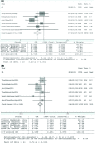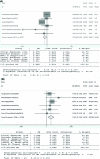A meta-analysis of the association of ApaI, BsmI, FokI, and TaqI polymorphisms in the vitamin D receptor gene with the risk of polycystic ovary syndrome in the Eastern Mediterranean Regional Office population
- PMID: 35958959
- PMCID: PMC9358239
- DOI: 10.18502/ijrm.v20i6.11439
A meta-analysis of the association of ApaI, BsmI, FokI, and TaqI polymorphisms in the vitamin D receptor gene with the risk of polycystic ovary syndrome in the Eastern Mediterranean Regional Office population
Abstract
Background: The results of case-control studies on the association between vitamin D receptor gene (VDR) polymorphisms and polycystic ovary syndrome (PCOS) are inconclusive.
Objective: We aimed to more precisely evaluate the correlation between the ApaI, BsmI, FokI, and TaqI VDR gene polymorphisms and PCOS susceptibility.
Materials and methods: PubMed, Scopus, Science Citation Index, and Google Scholar databases were searched to retrieve related reports released up to the end of 2020. To evaluate the association strength of the VDR gene polymorphisms with PCOS risk, pooled odds ratios (OR) with a 95% confidence interval were determined.
Results: In total, 1,119 subjects (560 PCOS cases and 559 controls) from 7 studies were included which met the inclusion criteria. A statistically significant association between the TaqI polymorphism and PCOS susceptibility was found in the Eastern Mediterranean Regional Office population (T vs. t: OR = 0.715; TT vs. tt: OR = 0.435, p 0.001; TT vs. Tt+tt: OR = 0.696, p = 0.01; tt vs. TT+Tt: OR = 1.791, p 0.001). It was found that the ApaI variant was a risk factor in the dominant inheritance model (AA vs. Aa+aa: OR = 1.466, p = 0.01) and the FokI polymorphism was a protective factor in the recessive inheritance model (ff vs. FF+Ff: OR = 0.669, p = 0.04). The VDR BsmI polymorphism did not show association with PCOS susceptibility.
Conclusion: Our meta-analysis revealed that the VDR ApaI in the dominant model, VDR FokI in the recessive model, and VDR TaqI polymorphisms in all genetic models are associated with vulnerability to PCOS. However, further studies with a larger sample size are required.
Keywords: Polycystic ovary syndrome; Polymorphisms; Vitamin D receptor.; Meta-analysis.
Copyright © 2022 Shahmoradi et al.
Conflict of interest statement
The authors declare that there is no conflict of interest.
Figures






Similar articles
-
Association of vitamin D receptor gene variants with polycystic ovary syndrome: a meta-analysis.BMC Med Genet. 2019 Feb 14;20(1):32. doi: 10.1186/s12881-019-0763-5. BMC Med Genet. 2019. PMID: 30764792 Free PMC article.
-
Association of vitamin D receptor BsmI, TaqI, FokI, and ApaI polymorphisms with susceptibility of chronic periodontitis: A systematic review and meta-analysis based on 38 case -control studies.Dent Res J (Isfahan). 2018 May-Jun;15(3):155-165. Dent Res J (Isfahan). 2018. PMID: 29922333 Free PMC article. Review.
-
Associations among four polymorphisms (BsmI, FokI, TaqI and ApaI) of vitamin D receptor gene and end-stage renal disease: a meta-analysis.Arch Med Res. 2015 Jan;46(1):1-7. doi: 10.1016/j.arcmed.2014.11.017. Epub 2014 Nov 27. Arch Med Res. 2015. PMID: 25434518 Review.
-
Association of vitamin D receptor gene polymorphisms, metabolic features and susceptibility to polycystic ovary syndrome: a preliminary study.Reprod Biomed Online. 2025 Feb;50(2):104447. doi: 10.1016/j.rbmo.2024.104447. Epub 2024 Sep 8. Reprod Biomed Online. 2025. PMID: 39753037
-
The Impact of Vitamin D Receptor Gene Polymorphisms (FokI, ApaI, TaqI) in Correlation with Oxidative Stress and Hormonal and Dermatologic Manifestations in Polycystic Ovary Syndrome.Medicina (Kaunas). 2024 Sep 14;60(9):1501. doi: 10.3390/medicina60091501. Medicina (Kaunas). 2024. PMID: 39336541 Free PMC article.
Cited by
-
Vitamin D receptor (VDR) gene polymorphisms and risk for polycystic ovary syndrome and infertility: An updated systematic review and meta-analysis.Metabol Open. 2024 Dec 31;25:100343. doi: 10.1016/j.metop.2024.100343. eCollection 2025 Mar. Metabol Open. 2024. PMID: 39866289 Free PMC article.
-
Relevance of Serum Levels and Functional Genetic Variants in Vitamin D Receptor Gene among Saudi Women with Gestational Diabetes Mellitus.Nutrients. 2023 Oct 8;15(19):4288. doi: 10.3390/nu15194288. Nutrients. 2023. PMID: 37836571 Free PMC article.
-
Do alkaline phosphatases have great potential in the diagnosis, prognosis, and treatment of tumors?Transl Cancer Res. 2023 Oct 31;12(10):2932-2945. doi: 10.21037/tcr-23-1190. Epub 2023 Oct 20. Transl Cancer Res. 2023. PMID: 37969388 Free PMC article. Review.
-
Hypermethylation and down-regulation of vitamin D receptor (VDR) as contributing factors for polycystic ovary syndrome (PCOS): a case-control study from Kashmir, North India.Arch Gynecol Obstet. 2024 Mar;309(3):1091-1100. doi: 10.1007/s00404-023-07326-9. Epub 2024 Jan 16. Arch Gynecol Obstet. 2024. PMID: 38227018
-
Association of Gene Polymorphisms with Polycystic Ovary Syndrome: A Meta-analysis.Gynecol Minim Invasive Ther. 2024 Sep 6;13(4):232-240. doi: 10.4103/gmit.gmit_106_23. eCollection 2024 Oct-Dec. Gynecol Minim Invasive Ther. 2024. PMID: 39660240 Free PMC article.
References
-
- Azziz R, Woods KS, Reyna R, Key TJ, Knochenhauer ES, Yildiz BO. The prevalence and features of the polycystic ovary syndrome in an unselected population. J Clin Endocrinol Metab. 2004;89:2745–2749. - PubMed
-
- Repaci A, Gambineri A, Pasquali R. The role of low-grade inflammation in the polycystic ovary syndrome. Mol Cell Endocrinol. 2011;335:30–41. - PubMed
Publication types
LinkOut - more resources
Full Text Sources
Miscellaneous
